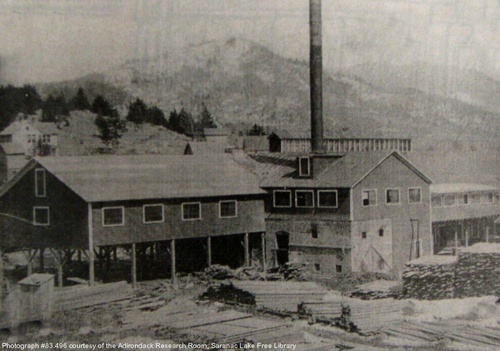 Branch and Callanan. Mount Baker, in the background, shows the effects of the 1908 forest fire; the Fish and Game Club raised funds to plant 14,000 new seedlings. Adirondack Daily Enterprise January 27, 2001
Branch and Callanan. Mount Baker, in the background, shows the effects of the 1908 forest fire; the Fish and Game Club raised funds to plant 14,000 new seedlings. Adirondack Daily Enterprise January 27, 2001 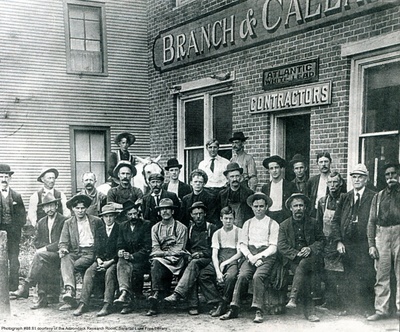 Branch and Callanan, 1890s. Adirondack Daily Enterprise, May 20, 2006 Branch and Callanan was a major local mill and contracting firm that was active in Saranac Lake's first building boom. Augustine Branch and William Callanan formed a partnership on May 16, 1892 and incorporated in 1901; they were originally from the Keeseville area. The firm was located at the end of Depot Street, between Union Depot and Broadway. By 1896, the mill in Saranac Lake was manufacturing doors, sash, and blinds used locally and shipped elsewhere. By 1902, they had two mills as well as contracting services, and were advertising:
Branch and Callanan, 1890s. Adirondack Daily Enterprise, May 20, 2006 Branch and Callanan was a major local mill and contracting firm that was active in Saranac Lake's first building boom. Augustine Branch and William Callanan formed a partnership on May 16, 1892 and incorporated in 1901; they were originally from the Keeseville area. The firm was located at the end of Depot Street, between Union Depot and Broadway. By 1896, the mill in Saranac Lake was manufacturing doors, sash, and blinds used locally and shipped elsewhere. By 1902, they had two mills as well as contracting services, and were advertising:
We can build your house from the ground and furnish everything. We have the facilities for building a cottage in two weeks as we have more than five hundred men in our employ. Don't wait to see us. Write, wire or telephone. 1
As contractors, Branch and Callanan built sixty buildings in 1908 alone, mostly in Saranac Lake and the vicinity. Many of the finest buildings in Saranac Lake were their work, as well as elegant Adirondack camps and homes elsewhere in the region. William Callanan, cofounder of the company, lived with his family at 19 Academy Street.
In 1960, William G. Distin, Jr., who had been with the firm since 1950 and had been its manager since 1953, bought the firm from the Callanan family; the Callanans had bought out the Branch family previously. 2Perry Parsons was a foreman with the company. The firm closed in 1993, 101 years after it was founded.
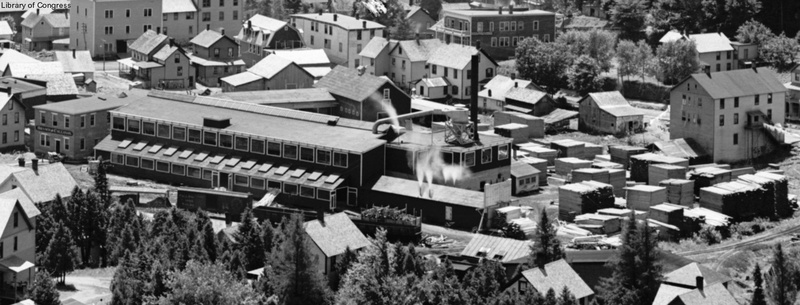 Branch and Callanan, 1902, from Mount Pisgah. Bloomingdale Avenue runs along the top left of the photograph, while Broadway is at the top right. A train is shown on the B&C siding in front of the building, and the wye used for backing and turning the train around is clearly shown on the bare ground to the right. For the full photograph by William Henry Jackson, see Saranac Lake Village, c. 1902 Buildings constructed
Branch and Callanan, 1902, from Mount Pisgah. Bloomingdale Avenue runs along the top left of the photograph, while Broadway is at the top right. A train is shown on the B&C siding in front of the building, and the wye used for backing and turning the train around is clearly shown on the bare ground to the right. For the full photograph by William Henry Jackson, see Saranac Lake Village, c. 1902 Buildings constructed
- Distin Cottage
- Dr. Henry Leetch House
- The Pink Palace
- George V.W. Duryee Cottage
- Gabriels Sanatorium
- Will Rogers Memorial Hospital
- First United Methodist Church
- Radwell Cottage
- Knollwood Club
- Saranac Laboratory
- The Porcupine
Adirondack Daily Enterprise, May 16, 1952
Branch and Callanan founded 60 Yrs ago
Founded on May 16, 1892 by William J. Callanan, then of Keeseville, and Augustine Branch, of Keene, its activities have extended to all points of the Adirondacks and northern New York.
For many years William J. Callanan was the active head of the business. Following his death in January, 1941, Andrew W. Callanan succeeded to the presidency. At the time of his death in May, 1944, the presidency went to Mrs. Marie C. Jaquet, his sister and daughter of the founder. Mrs. Jaquet continues in that capacity.
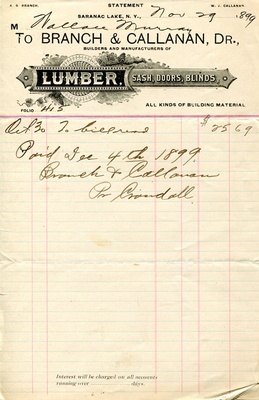 Branch and Callanan statement to Wallace Murray, 1899 Other officers today are Paul F. Jaquet, vice-president; John G. Whelley, secretary-treasurer; Robert Cuneo, assistant treasurer; Joseph Catillaa, assistant manager; Russell Woodruff, yard foreman, and Oakley Thompson, superintendent.
Branch and Callanan statement to Wallace Murray, 1899 Other officers today are Paul F. Jaquet, vice-president; John G. Whelley, secretary-treasurer; Robert Cuneo, assistant treasurer; Joseph Catillaa, assistant manager; Russell Woodruff, yard foreman, and Oakley Thompson, superintendent.
During its early years, Branch & Callanan acquired land and rail-sidings at the end of Depot Street and adjoining the Delaware & Hudson tracks, and proceeded to construct factory buildings which were equipped to turn out doors and window sashes in quantity. A variety of millwork was done in the plant and for many years the firm employed a large number of workers. Its weekly payroll sometimes ran into the thousands of dollars. Employment in those days was steady; men not at work on construction were employed during dull seasons in mill work which was later sold to other builders and contractors.
The days were those of steam-powered machinery and the boiler room, shafts and pulleys that furnished power for lathes and milling machines constituted quite a complicated piece of engineering work. One factory building had been built onto another to accommodate a growing business, and the plant rambled about the acres of ground between Broadway and the railroad tracks. The advent of electricity and faster and more efficient machinery followed. Among the large undertakings in building by the firm were the Hotel Saranac and construction of such extensive plants as those of the Eagles' Nest camp, Blue Mountain Lake and the Cole ranch buildings at Lake Placid. The firm built Gabriels Sanatorium the Will Rogers Memorial Hospital and many of the buiidings at Trudeau Sanatorium. During the last ten years, several houses and the Sara-Placid Drive-in theater have been added to the list.
In 1930 the extensive old frame building of the millwork plant on the Branch and Callanan property went up in flames. Only the brick office building was left and that almost entirely rebuilt. Immediately after the fire, Branch and Callanan entered the retail field and established sales rooms for a paint department, supplies for home owners and small contractors with hardware fixture department and an unfinished furniture stock.
The firm also built several modern and fireproof buildings for the production of special mill work and other woodwork used in quantity.
Adirondack Daily Enterprise, May 22, 1993
Branch and Callanan: A piece of Saranac Lake history
By KATHLEEN HALEY Enterprise Staff Writer
SARANAC LAKE — Take a short jaunt down to the quiet end of Depot Street to find Branch and Callanan; established in 1892 as a builder of houses, hotels and other bits of Tri-Lakes history.
The pale brick-and-wood two-story structure sits solidly across from what was once the bustling train station. Listen closely and a wind-whispering whistle might remind one of the trains passing in and out of the wood green and red camp-like station.
Passengers might have been stepping down off of the train or a coffin might be solemnly loaded into a cargo tram as cement and other building supplies are carried off of the train directly to the supply space of Branch of Callanan.
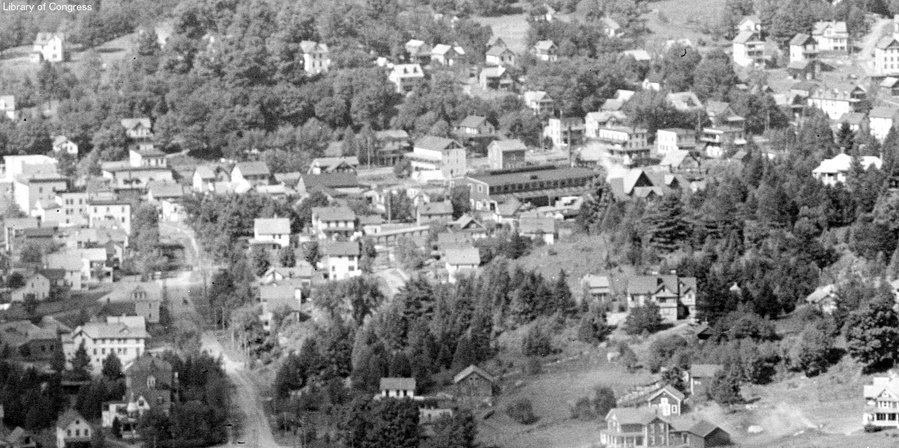 Branch and Callanan's big Planing Mill can be seen a little right of center, across from the new Union Depot in this 1909 photograph from Mt. Baker. Bloomingdale Avenue runs up from the left side of the photograph, and Broadway is visible above and parallel to the Planing Mill.
Branch and Callanan's big Planing Mill can be seen a little right of center, across from the new Union Depot in this 1909 photograph from Mt. Baker. Bloomingdale Avenue runs up from the left side of the photograph, and Broadway is visible above and parallel to the Planing Mill.
Within the mills' outbuildings, men in heavy black aprons work machines preparing wood and grinding out wood chips, trucks roll out of the lot filled with lumber and designers and architects plan their next project
Those images are now only remnants of years past as the current owners William "Mo" and Mi Li Distin, Jr. are liquidating their merchandise to close up shop. The Distins reopened the shop Tuesday, May 18 for final liquidation.
Sitting in the main building, which houses many remaining building supplies, paint, tools, nails, etc., Mi Li Distin pulled out some of those images from the past 100 years which show the people who worked there, the projects they constructed all over the North Country and maps of Saranac Lake's former self.
Many of the company's ledgers, maps and photos were donated this year by the Distins to the Historic Saranac Lake Society for use by the public.
The Distins held back a few of the photo books and maps just to take a closer look at them before they are all donated to the society. Included in the pile of black and white memories are pictures, possibly of the founders of the business, Augustine Branch and William Callanan, and their workers when they first set up keep in 1892.
William G. Distin, Jr. joined the staff as a designer in 1950 and took over management in 1952. In 1960, he became sole owner of the company.
Mi Li Distin pointed out when Branch and Callanan started their business on Depot Street there wasn't much around except fields, a good place to have stacks of lumber and massive red outbuildings to accommodate that type of manufacturing.
William Distin noted that most wood was cut locally until recently, when it was shipped from Canada and companies such as Georgia-Pacific, The wood would be processed in the mills and formed into lumber or window or other specialty housing frames.
At one time, he continued, the business employed more than 50 people, with the ranks swelling during major construction projects throughout the Adirondacks.
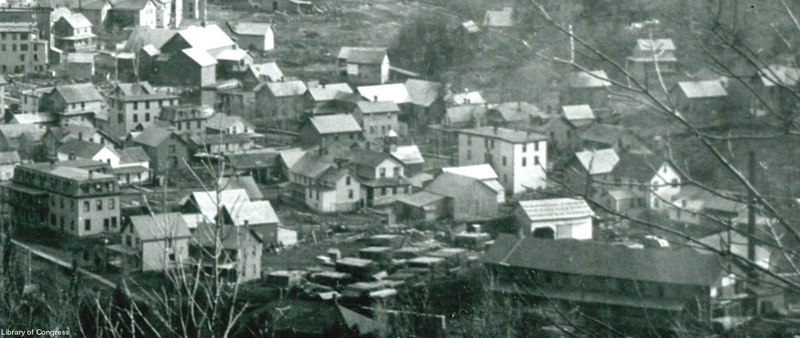 Branch and Callanan appears in the lower right hand corner of this 1895 photograph from Mt. Pisgah.
Branch and Callanan appears in the lower right hand corner of this 1895 photograph from Mt. Pisgah.
The Grand Union Hotel (then called the Franklin House) can be seen at left.
Throughout the worn photo albums are pictures of the mighty projects that Branch and Callanan took on, which have now become historical and celebrated buildings within the Adirondacks.
Pictures of buildings under construction also fill the album. From the Will Rogers Hospital to the Chapel at the Lake Placid Club, the Distins' old time photographs record the laborious process of building some of the most distinguished landmarks in the area.
Notably, William G. Distin, Sr., Distin's father, was an architect who drew up plans for many of Branch and Callanan's projects. William Distin Jr., though not an architect like his father, helped design some of the plans that Branch and Callanan constructed.
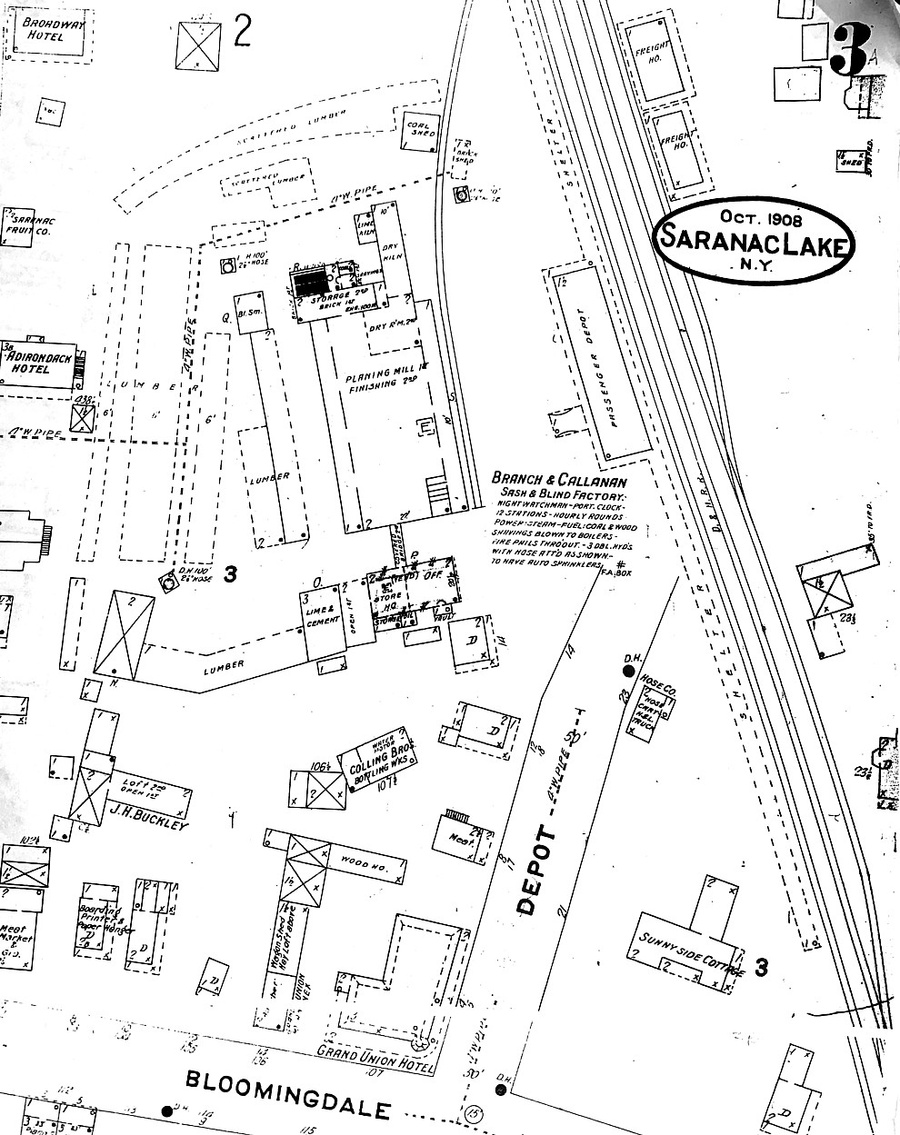 1908 Sanborn map detailOther famous landmarks constructed through the work of Branch and Callanan include the Hotel Saranac, the cottages at Trudeau Sanatorium, the Trudeau chapel, Sunmount Hospital, Gabriels Sanatorium, the Saranac Lake Methodist Church, the Agora at the Lake Placid Club, the Lake Placid Union Free School and the AuSable Chasm School.
1908 Sanborn map detailOther famous landmarks constructed through the work of Branch and Callanan include the Hotel Saranac, the cottages at Trudeau Sanatorium, the Trudeau chapel, Sunmount Hospital, Gabriels Sanatorium, the Saranac Lake Methodist Church, the Agora at the Lake Placid Club, the Lake Placid Union Free School and the AuSable Chasm School.
Also to their credit, Branch and Callanan designed and constructed many of the Adirondack "great camps" like the William Rockefeller camp now known as "The Point" and the Hochschild camps in Blue Mountain Lake. As an interesting aside, it was at the Hochschild camp — after its completion — where Mi Li Distin first met the men who would later become her father- and brother-in-law.
In other historical materials, Mi Li Distin also pulled out a bill of sale dated 1893 for the home of Edward Livingston Trudeau, built by Branch and Callanan, for services and construction supplies. In a slow, cursive handwriting, the bill is written out: 110 foot of spruce cost $1.98, a can of paint was worth $2.63 and three quarts of varnish, $1.50.
The Distins are also sorting through some blueprints, one from 1888 which plans out the buildings of the Branch and Callanan, showing the "Chateaugay Railroad Company"]. One whole three-foot-long leather-bound book contains pages of mappings and descriptions of the entire Saranac Lake village, including homes, businesses and water lines running underground.
Historic Saranac Lake Director Sharon O'Brien said the old ledgers, maps and other materials, which were donated to the society, can be used for research by individuals at the Historic Society. O'Brien added that the materials "are real gems" from the historical vantage point.
"We've already had a few phone calls" about people wanting to see what their old house might have looked like or designed when it was first built, O'Brien said. She added that a lot of young people moving into the village have wanted to study the blueprints to try and redesign their homes to their former state.
The Distins said they still have some old window frames left to be sold, as well as much lumber — just in time for the building season. After they liquidate, Mi Li Distin said they will continue to live in Saranac Lake for part of the year.
Walking out to the two-story storage buildings, Mi Li Distin showed off some of the remaining window frames and wooden moldings. She said someone suggested, somewhat jokingly, that the high-ceilinged buildings with sturdy cement floors would make a good nightclub.
In one section of a storage building, a charred doorway represents one of several fires that have ravaged the Branch and Callanan buildings throughout the years. The main building escaped largely unscathed, with the exception of a 1930 blaze which slightly damaged the structure.
The buildings – with the exception of the main offices – remain mostly empty of workers and equipment but reminders of the hard work remain.
Adirondack Daily Enterprise, May 1, 1992
Celebrating Their 100th Year
The firm was founded on May 16, 1892, as a partnership by William J. Callanan, then of Keeseville, and Augustine Branch of Keene. The partners incorporated the business under the laws of New York state in 1900.
For many years William J. Callanan was the active head of the business and he remained so until his death in January of 1941. Mr. Callanan was a man of wide interests, and under his aggressive management Branch & Callanan extended its contracting business to large undertakings in various parts of the North Country. It was under his management that the firm built the Hotel Saranac.
Developed Large Factory
During its early years Branch an Callanan acquired land and rail sidings at the end of Depot Street and adjoining the Delaware & Hudson tracks, and proceeded to construct factory buildings which were equipped to turn our doors and window sash in quantity.
A variety of millwork was made in the plant, and for many years the firm employed a large number of workers and its weekly payroll to Saranac Lake some times ran into the thousands of dollars. Employment in those days was steady, men not at work on construction being employed during dull seasons in millwork which was later sold to other builders and contractors.
Asset to Saranac Lake
In its years of activity Branch & Callanan has been an asset to the commercial and industrial life of Saranac Lake. Many of the projects completed in the community have been brought into being through the efforts of the officers of the firm, regardless of the subsequent awarding of contracts.
Cheryl Lyon, office manageress, whose father and grandfather also worked for Branch & Callanan, adds her third generation heritage of building experience to the company's background of knowledge.
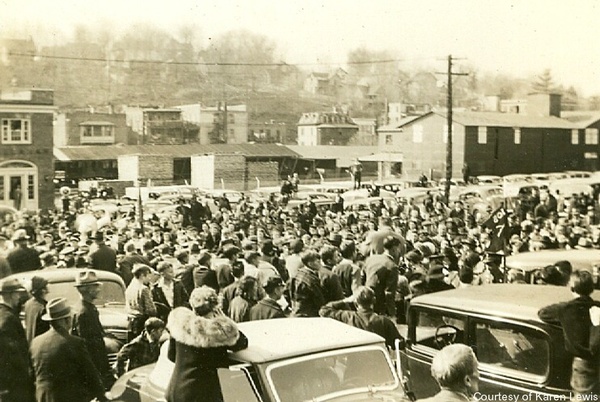 Branch and Callanan, looking towards Broadway, c. 1940. In the last couple of years a large addition has been made to the office building on the left, where the stacks of lumber are in the photo. The context in which this photograph was found suggest that the crowd at Union Depot is sending off troops for training in Alabama.
Branch and Callanan, looking towards Broadway, c. 1940. In the last couple of years a large addition has been made to the office building on the left, where the stacks of lumber are in the photo. The context in which this photograph was found suggest that the crowd at Union Depot is sending off troops for training in Alabama.
Bill Distin's association with the business goes back far in the construction firm's long history. His father, also William G. Distin, was a renowned architect in the area who designed famous landmark Adirondack buildings, some of which are The Point on Upper Saranac Lake, Eagle's Nest Camp in Blue Mt. Lake and the Agora and Chapel buildings at the Lake Placid Club, all of which were built by Branch & Callanan. Mr. Distin joined Branch and Callanan in 1950, became manager of the business in 1953 and bought the business in 1961. He has chosen to approach the design and construction of buildings through hands-on experience, to offer his customers the practical construction expertise they need.
Although the firm has built many area landmarks and is known for high-quality construction, it still offers highly competitive prices. Being able to offer its customers construction services from raw materials to actual contracting work gives Branch & Callanan a competitive edge. The firm can compete with the chain lumberyards because, since it also runs a construction business, it can afford to order wood wholesale. Having its own lumber supply also ensures that the construction business will obtain wood and other supplies at reasonable prices, and pass the savings on to customers.
Essex County Republican, May 3, 1894
--The contract for the masonry of Dr. Trudeau's new laboratory at Saranac Lake has been awarded to Branch & Callanan of Saranac Lake, for $20,000
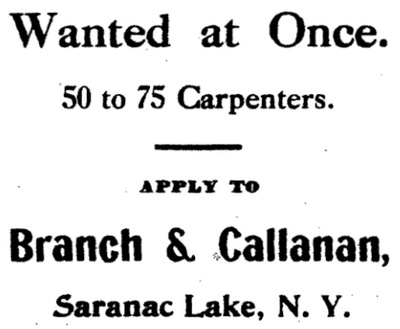 Malone Farmer, May 16, 1906Elizabethtown Post, May 2, 1901
Malone Farmer, May 16, 1906Elizabethtown Post, May 2, 1901
Saranac Lake Village Suffers a Heavy Loss by the Burning of Branch & Callanan's Planing Mill.
Branch & Callanan's woodworking shops and lumber yards at Saranac Lake village were destroyed by fire Sunday evening, entailing a loss estimated at from $40,000 to $50,000. The insurance is $24,000. Two cars on tracks in the lumber yard were also burned and many near by dwellings damaged.
The Saranac Lake fire department was assisted by the Malone department, which came by special train, reaching Saranac Lake village at 8:30 o'clock Sunday evening. At 10:80 o'clock the fire was under control.
The fire was the most disastrous that ever visited Saranac Lake village. It started about 4 o'clock Sunday afternoon in the drying room of the planing mill and burned rapidly. The mill, operated by steam, was near the Chateaugay R. R. depot. The firm's property was located in that part of the village about seven years ago, having been removed from a site near the Riverside Hotel.
Branch & Callanan are large contractors and builders. Augustine Branch went to Saranac Lake eleven years ago from the town of Keene, Essex County, being a brother of Frantz and Ruthvon Branch, still residents of that town. Mr. Callanan went to Saranac Lake from Keeseville and the two men have worked well in the business harness together, building up a large and lucrative trade. Unquestionably they have erected more Adirondack hotels and cottages than any other firm. Their business is the largest industry in the Saranac Lake section. The firm used much dressed lumber and their planing mill was established to accommodate their own business. The firm erected many of the dwelling houses in Saranac Lake village, the summer cottages on Upper and Lower Saranac Lakes, Paul Smith's and many buildings in the entire vicinity of the Saranacs. They also erected D. Crawford Clark 's fine house near the line between the towns of Essex and Willsborough and the exceptionally well appointed cottage which adorns the Sage property in the Aiden Lair section of the town of Minerva.
Lewis L. Lobdell, eldest son of Jerome T. Lobdell of Elizabethtown, is one of Branch & Callanan's most trusted lieutenants, having been with them the past ten years. Mr. Lobdell superintended the construction of the D. Crawford Clark house and the Sage cottage above referred to and has been an invaluable man to Branch & Callanan.
The firm had a large amount of work on hand for the. opening of the season. It is understood that the mill will be rebuilt at once. About 200 men are temporarily thrown out of employment. The firm will use their upper mill, so called, while the burned building is being reconstructed.
A house belonging to Mrs. Rose Scriver, widow of the late Wm. Scriver of Elizabethtown, caught fire repeatedly Sunday evening and was saved only through the heroic exertions of several men constantly employed on it.
Adirondack Record-Elizabethtown Post, September 4, 1930
SARANAC LAKE BLOCK`WIPED OUT IN $250,000 FIRE
Branch & Callanan Mill Working Plant Entirely Destroyed in Spectacular Blaze
A $260,000 fire which wiped out a solid block in the business district of Saranac Lake threw that community into a panic about midnight on Saturday night and aroused residents of communities for thirty miles around. It was not until twenty hours after the discovery of the blaze that the flames were entirely wiped out and heaps of black and smoking ruins remained on what had only the previous day been one of the largest and most important industries of the Adirondack resort. The property destroyed was the mill working plant of the Branch & Callanan Company, and the fire has put out of employment two hundred carpenters and mill workers, who had found steady employment in the plant which stood opposite the union depot in the down-town section of the village.
Although the fire was declared under control at 3 a. m., Sunday, hose-men continued throughout the day to battle flames that smouldered and burst out occasionally in the ruins.
Unofficial estimates of the loss, which included large quantities of machinery, ran as high as $400,000, but village police made the more conservative estimate pending a checkup by owners of the property. The company is one of the largest in the state, specializing is the construction of camps and hotels at Adirondack resorts. In 1901 a similar fire destroyed its plant. Not since the 1901 fire have Saranac Lake and its surrounding communities witnessed a spectacle of Saturday night's proportions. At 10 p. m. a passerby reported a sudden glow of flame in a window of the barn where the last four of a once large stable of horses were kept. An hour later the barn was a roaring furnace and was spreading.
Shortly after midnight fire ate its way into the huge planing mill where seventy men worked in busy seasons. Other structures on the property caught fire. Alarmed residents in a nearby row of dwellings began to evacuate. About that time a call was sent to Lake Placid for help. And when the roof of the mill collapsed with a great roar a few minutes later firemen telephoned to Tupper Lake, thirty, miles distant.
Meantime Philip Adler, aiding a group of firemen in saving the horses, was overcome by smoke and was carried out unconscious. He revived later.
Thousands of villagers and residents for miles around got out of bed and swarmed to the scene, lured by the roar of the flames, which was audible throughout the village, and by the scarlet glow and waves of billowing black smoke which rose against the sky.
The glow lighted up mountains for miles around, and summer visitors, many of them passing their last night in camp before starting home, went into the village. Highways, ordinarily deserted at the late hour, shone with streams of headlights.
Down through the growing traffic roared the fire departments of Lake Placid and Tupper Lake. The two pieces of Saranac apparatus, far over-worked and already feeling the handicap of decreasing water pressure, were throbbing hotly when the Lake Placid pumper whirled into town, its driver reporting a ten mile run in twelve minutes.
Meanwhile the Tupper Lake pumper came at high speed over the tortuous macadam mountain highway. Firemen reported that the engine had arrived and was pumping forty-eight minutes after it had started out on the thirty mile run.
Fifteen thousand spectators were estimated to be in the crowd which assembled from Saranac, Lake Placid, Paul Smiths, Upper and Lower St. Regis Lakes and Upper Saranac. These swarmed in Broadway, Depot and Bloomingdale avenues, crowded the roofs of nearby business buildings and overflowed to the tracks of the Delaware and Hudson and New York Central railroads. To relieve the water shortage fourteen hose lines were extended to the Saranac river. Many of these were used to protect the dwellings which at first were believed could not escape destruction. Village officials complimented the firemen on the fight they put up with only two pieces of apparatus.
A checkup when the fire was put under control showed the destroyed structures included the barn, planing mill and its elaborate machinery. office building, garage, storehouses, lumber and shingle stacks and sheds. An adjoining garage and an apartment house were damaged.
Adirondack Daily Enterprise, March 11, 1965
FIRE SINGES NEW FIRE HOUSE
Huge Shed Burns; Others Are Saved
Billows of black smoke filled the clear skies over Saranac Lake's business district this morning as a storage shed of The Branch and Callanan Lumber company burst into flames.
The fire, of unknown cause, started in the shed behind the Adirondack Body Shop at 11 and within minutes spread to the length of the shed. The intense heat, fanned by slight gusts spread the fire to another shed behind the company's main office. Further damage was prevented by firemen, braving the intense heat, stood between the burning shed and poured water onto the remaining shed.
Several small explosions were heard as the fire raced the length of the second shed.
In less than ten minutes from its start, the flames had engulfed the buildings and the burning framework of the roof was visible to the mass of spectators that had gathered.
Firemen were able to bring the blaze under control in approximately 30 minutes.
A company spokesman estimated the damage to the lumber yard at between $50,000 and $75,000.
Only the constant streams of water playing on the row of houses and building across the ten foot ally from the burning sheds prevented the extension of the fire onto Broadway.
The fire house itself was on fire for several minutes near the top of the building and the chunks of stucco peeled and fell from the brick of the building.
The eager volunteers flooded into upstairs rooms of the fire house to move equipment from the living quarters to the safer front rooms near the street.
Bloomingdale Mutual Aid was on the scene to help fight the spread of the fire.
The nearly completed addition to the fire house was slightly damaged in the rear and the panes of glass were broken by the heat and later smashed to the floor as the heavy spray from the hoses was moved along the building.
The board fence that enclosed the Branch and Callanan property were soon blazing as the telephone and electric lines poles along the alley were black and smoldering.
Under control by 11:25 the firemen continued to spray water on the houses and the many piles of plywood, that by this time looked like large charred stacks of catalogues. Some salvage of the inside pieces of plywood was probable, according to observers.
In the cold sunshine the water from five fire hoses in the alley created rainbows whose beauty was in sharp contrast to the desolation left by the raging fire.
Phones reporting the fire rang in the fire house at the same instant that the firemen and Village Manager Stan Savarie noticed the smoke outside their back windows. Though the cause of the fire remained undetermined, it is known that the fire began directly behind the Adirondack Body Shop, next to the Potter Block on Broadway. The plastic storm windows as well as the glass windows of the side of the body shop were broken. The five cars stored in the shop were immediately removed. One car's motor wouldn't start, and had to be pushed from the shop. No damage to the inside of the building was apparent.
The apartment houses at 93 and 97 Broadway sustained some smoke damage and Miss Laura Disco's building was charred on the white pillars in the back next to the ally. The wind direction, southwesterly, was a determining factor in preventing more serious damage to the Broadway buildings, according to Fireman Francis Gladd.
By 12 noon, about one hour after the start of the fire, it was reduced to rising puffs of white steam as the heat of the remaining smoldering wood vaporized the water from the hoses.
Most people remained in their apartments in the threatened section on Broadway. All electric service and telephone service was immediately cut off to prevent further dangers from the burning and frayed wires and smoldering transformers that lined the alley.
Activity at Libby's Beauty Shop came to an abrupt halt at 11 a.m. and distraught women were trapped with half-done hair styling. #
Two photos accompanying the above article were captioned:
FIREMEN on roof of Currier Press building spray hoses on flame swept area below which threatened several buildings along Broadway including the fire house itself. Heat from the blazing sheds cause Telephone lines and poles to catch fire in the alley section between the burning buildings and Broadway.
LUMBER SHEDS at Branch and Callanan with raging flames out of control during the early part of today's fire which leveled the long frame buildings. Explosions from gasoline tanks and heavy black smoke from stored tarpaper kept firemen busy trying to attack the flames from a hydrant which was only a few feet from the main inferno.
Ad in The Adirondack Enterprise, July 17, 1902:
A. S. Branch / W.J. Callanan / Branch & Callanan / Incorporated Manufacturers of / All Kinds of Building Materials, /Including Sash, Doors and Blinds; Spruce, Pine / and Cedar Shingles of all grades; Lath, Clap- / boards, Spruce and Hemlock Dimension Stock / and Mouldings of Every Description. Also / Oak, Maple, Birch, Spruce and Southern Pine / Flooring and Ceiling, and all Grades of White Pine.
A Select Stock of Quartered Oak, Whitewood and all / kinds of Hardwood Lumber on Hand.
Mantels, Stairwork, Counters and Fine Hardwood / Work are some of our Specialties / and are better able than ever before to fill orders.
We draw plans [illegible] cottages and would lik[e to] figure on your work.
Estimates cheerfully furnished and correspondence solicited / Remember the place--near Chateaugay Station.
Hydraulic Press and Fire Brick
We sell Rosedale Cement, Portland Cement, Calc[illegible]d / Plaster and American Hard Wall Plaster, and are / Branch & Callanan / Incorporated Builders and Manufacues [sic] /
Saranac Lake, N.Y.
Other local builders
Comments
Footnotes
1. Adirondack Daily Enterprise July 3, 1902.
2. Adirondack Daily Enterprise May 16, 1962.



